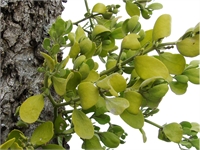
Health Benefits of Mistletoe
Important Notice: Our web hosting provider recently started charging us for additional visits, which was unexpected. In response, we're seeking donations. Depending on the situation, we may explore different monetization options for our Community and Expert Contributors. It's crucial to provide more returns for their expertise and offer more Expert Validated Answers or AI Validated Answers. Learn more about our hosting issue here.

Health Benefits of Mistletoe
You must be logged in to post a comment.
For centuries, mistletoe was used in traditional medicine to treat seizures, headaches, and other serious health conditions. Even today, mistletoe is a widely-prescribed treatment for cancer in Europe. But it is essential to recognize from the onset that while mistletoe may indeed possess numerous health benefits, raw, unprocessed mistletoe is poisonous. Consuming it as you would other natural curatives can cause vomiting, seizures, difficulty breathing, a slowing of the heart rate, and even death. (Many herbalists consider the American variety of mistletoe totally unsafe for medicinal use.)
In lore and antiquity
Since ancient times, mistletoe has been considered one of the most magical, mysterious, and sacred plants in all nature. Believed to possess the power of life and fertility, the ancient Celts cut mistletoe with golden sickles while reciting magickal incantations, to be later used in powerful winter rituals. They believed mistletoe protected those who possess it from all evil, and that the oak trees on which it grew were sacred. This tradition continues today with many neopagan and Wiccan groups.
Through the centuries, mistletoe became known throughout Europe as a natural curative for a number of medicinal conditions. In the 16th century, for example, mistletoe was prescribed to improve circulation and relax tight muscles. Other uses included the treatment of internal bleeding, convulsions, infertility, arthritis, rheumatism, gout, hysteria, whooping cough, asthma, hypertension, headache, dizziness, menstrual cycle and menopausal symptoms, diarrhea, chorea, and rapid heartbeat. And while no anecdotal history as to its effectiveness survives, it is said to have been used in the 17th and 18th centuries as a tranquilizer for various nervous conditions including mental and physical exhaustion. And in more recent centuries, mistletoe has been used to prevent hardening of the arteries and to lower blood pressure. What is not known, however, is the process used to extract its medicinal qualities.
The science
Mistletoe (All Heal, Birdlime, Devil’s Fuge, Donnerbesn, Golden Bough, Holy Wood, Lignam sanctae crucis, Misseltoe, Thunderbesem, Witches Broom, and Wood of the Cross) is an abundantly growing parasitic evergreen which grows on branches and trunks of a variety of deciduous trees (frequently on oaks), where it forms pendent bushes 2-5 feet in diameter. Its leaves are thick and leathery, oval to round, and 1-2 inches long. The small flowers it produces in the spring leave behind distinctive white, sticky, autumn berries, about 1/4 inch long. The species most commonly used for medicinal purposes are the American mistletoes (the most prevalent of which is Phoradendron serotinum) and European mistletoe (Viscum album L.), both of which are from the family Loranthaceae and look almost identical.
Studied today for its potential as a cure cancer, mistletoe has been tested in Europe in more than 30 clinical trials. Studies report that mistletoe does indeed kill cancer cells, while stimulating the immune system. However, although improvements in survival or quality of life have been reported in cancer patients, almost all of the trials had major design flaws that raise some doubts among the scientific community as to their validity. For example, most of the studies were based on small numbers of participants–and therefore did not represent a cross-section of cancer sufferers. Other trials used no control group.
What is known, however, is that mistletoe possesses a number of somewhat unique chemical compounds including viscotoxins (small proteins that exhibit cell-killing activity and immune system stimulating activity), alkaloids (a large group of plant-produced nitrogen-containing chemicals that may have anticancer properties), and lectins (complex molecules that contain both protein and sugars that bind to the outside of cells thus inducing biochemical changes that may be responsible for the reported beneficial effects of mistletoe). Additionally, mistletoe contains choline, acetylcholine, flavonoids, histamine, and mucilage.
In Europe and Asia, mistletoe preparations are distinguished according to the species of host tree from which they are gathered. For example, both fermented and non-fermented extracts are prepared from apple, pine, oak, spruce, and popular trees, each sold under a different brand name (apple: IscadorM, pine: IscadorP, etc).
The health benefits of mistletoe
Today, mistletoe is used primarily in Europe and Asia, where extracts are administered by intramuscular injections, subcutaneous injection (sometimes in the vicinity of a tumor), or intravenous infusion. (In the United States, mistletoe by injection is available only in clinical trials.) In European countries like Germany where commercial mistletoe is available, mistletoe extracts are considered generally safe when used according to product directions and under the supervision of a healthcare provider. However, because mistletoe has not yet been proven to be a safe and effective cancer treatment by American standards, health authorities warn that it should not be used outside clinical trials. Additionally, herbalists caution against the use of any herbal supplement containing mistletoe and advise you to inform your healthcare providers if you are doing so as the side-effects of this herb, as well as how it interacts with other medications, are unknown.